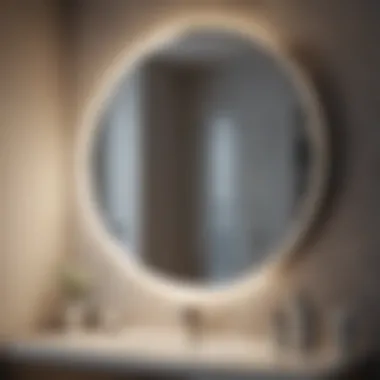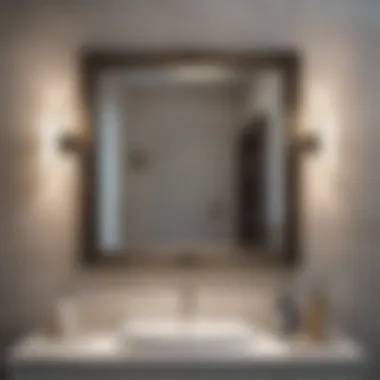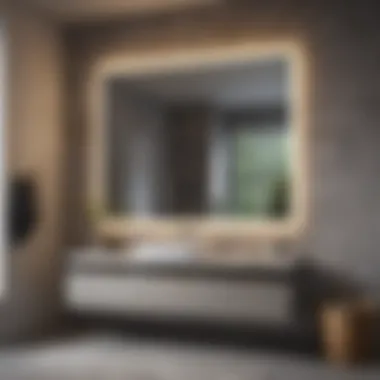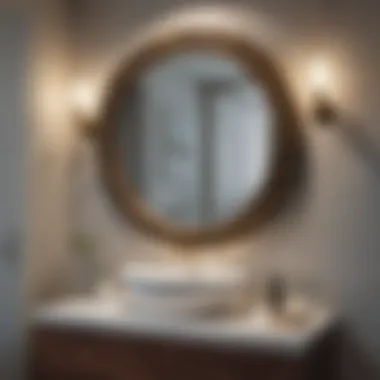Selecting the Right Dimensions for Bathroom Mirrors


Intro
When it comes to selecting a bathroom vanity mirror, the dimensions play a crucial role. After all, the right size isn’t just a matter of looks; it’s about functionality and how well the mirror complements the overall design of your space. In this guide, we will navigate through the essentials of choosing the ideal bathroom mirror while considering factors like space, style, and personal needs. It’s more than just hanging glass on the wall—it's about creating a haven that feels just right.
Design Inspirations
Exploring the design elements that influence mirror selection can truly elevate a bathroom’s appeal. Let’s break it down into two main themes: modern versus traditional styles, along with color and texture choices.
Modern vs. Traditional Bath and Bedroom Styles
Understanding your bathroom's existing style helps establish what kind of mirror works best. Modern designs lean towards minimalist approaches. Large rectangular or round mirrors with clean lines often shine in such setups, providing a sense of openness.
On the flip side, traditional styles might incorporate ornate frames and vintage elements. Mirrors in this category not only serve practical needs but also add character. They might be available in warm finishes or elegant shapes, giving a nod to classical design.
Color Palettes and Textures
When choosing a mirror, it's essential to align the color and texture with your bathroom’s palette. For a tranquil vibe,
- Soft whites and pastels might be favored.
- Alternatively, bold colors could make a statement and serve as a focal point.
Textures also play a pivotal role. A wooden or metallic frame can introduce warmth and richness, amplifying the overall aesthetic. This attention to detail can enhance not just the mirror, but the entire bathing experience.
Key Considerations in Sizing
How do you know what size mirror is appropriate for your bathroom? Here are some important points to ponder:
- Height and Placement: Generally, the center of your mirror should be eye-level. If multiple users are in play, consider where to place it for accessibility.
- Width Relative to Vanity: A good rule is to have the mirror width equal to or slightly wider than the vanity. It creates balance, making the space feel cohesive.
- Space Proportions: For smaller bathrooms, oversized mirrors can create an illusion of a larger area. Conversely, in spacious settings, a mirror that’s too small may get lost in the design.
Practical Tips for Enhanced Functionality
In addition to aesthetics, think about how the mirror can be more than just a reflection:
- Incorporate lighting: Backlit mirrors or those framed with ambient lighting can brighten areas that need it.
- Consider storage options: Some mirrors offer built-in shelves or cabinets for convenience.
"A well-chosen mirror does not just reflect, it defines the nature of the space."
Synonymous with Personal Traits
Ultimately, the best mirror for your bathroom reflects not just your physical appearance, but also your personal style and preferences. Whether you opt for sleek modernity or cherish the charm of tradition, focus on the specific needs of your home while keeping functionality at the forefront.
Prelude to Bathroom Vanity Mirrors
In the realm of home decor, the bathroom often gets relegated to afterthought status. Yet, the selection of bathroom vanity mirrors plays an essential role in both function and style. Mirrors do more than simply reflect; they can transform the appearance of the space, create the illusion of depth, and enhance lighting. The mirror you choose sets the tone for your bathroom design, whether you lean toward a sleek modern aesthetic or something more traditional. This article aims to decode the dimensions of standard bathroom vanity mirrors, helping homeowners and designers alike select the perfect mirror that fits both their needs and their decor style.
The Role of Mirrors in Bathroom Design
Mirrors provide significant advantages beyond their reflective properties. They serve as practical tools for daily grooming routines, from shaving to skincare. However, their impact stretches much further. A well-placed mirror can brighten a dimly lit space, contributing to an airier ambiance. They can also showcase design elements—think of how a stylish frame can complement your cabinetry or tile work. When designing a bathroom, considering the placement and dimensions of mirrors is as important as coordinating color schemes and materials.
For instance, a large mirror invites more light and creates a focal point, while smaller mirrors can lead to a more intimate feel. By understanding the interplay between mirror size and the overall bathroom design, homeowners can make choices that elevate the entire space. Whether in a minimalist setting or a richly detailed traditional one, mirrors enhance visual coherence.
Importance of Choosing the Right Size
Size matters—especially when it comes to mirrors. Selecting a mirror that is too small can result in a sense of imbalance, making a beautifully designed bathroom feel lacking. On the other hand, a mirror that dominates the wall may overshadow other design elements, creating visual clutter. The key is finding the sweet spot where form meets function.
A common guideline suggests that mirrors should span about two-thirds of the width of the vanity. This proportion maintains harmony and draws the eye to the vanity itself, strengthening the design.
In addition, the size of the mirror can also affect how comfortable it is to use. The ideal height allows users of different statures to see their reflections clearly. Think about the typical users of your bathroom: if it's a family space, a slightly taller mirror can accommodate both children and adults. Therefore, taking time to assess the available wall space and understand the intended use will lead to a more informed choice.
By delving into the dimensions of bathroom vanity mirrors, we equip readers with knowledge that goes beyond basic selections. In an era where thoughtful design enhances our daily lives, understanding mirror dimensions can make a significant difference.


Standard Dimensions of Bathroom Vanity Mirrors
When selecting the right bathroom vanity mirror, understanding standard dimensions can make or break the aesthetic and functionality of your space. The right mirror does more than just reflect your image; it helps create an illusion of space, enhances natural light, and contributes to the overall design theme of the bathroom. Whether you're sprucing up a master bath or a small powder room, knowing the dimensions that work best with your vanity can lead you to a decision you won't regret.
Common Sizes for Single Vanities
For single vanities, mirrors typically range from 24 to 36 inches wide. The standard height varies but often falls between 30 to 40 inches. This sizing caters to the average height of users, making it ideal for daily routines, such as applying makeup or shaving.
It's essential to consider the width of the vanity itself when choosing a mirror. A good rule of thumb is to select a mirror that does not exceed the vanity's width by more than a few inches. For instance, if you have a 30-inch single vanity, aiming for a mirror around 28 to 32 inches wide creates a balanced look. Anything larger might look out of place, while anything smaller could feel disproportionate, directly affecting the room's flow.
Typical Sizes for Double Vanities
With double vanities on the rise, mirrors designed for these spaces have their own set of dimensions. Standard sizes typically range from 60 to 72 inches in width and about 30 to 36 inches in height. Here, accommodating two users means considering the division in space; hence, choosing matching mirrors or one continuous mirror that spans the full length can help in achieving symmetry.
When selecting a double mirror, consider how it will sit in relation to the countertop. Ideally, the bottom edge of the mirror should hang about 5 to 10 inches above the vanity top, to allow comfortable viewing while standing or sitting.
Variations Based on Vanity Height
Vanity height is a key player when it comes to selecting the right mirror. Most vanities stand between 30 and 36 inches tall, so a mirror should be proportionate to the vanity's height to maintain comfort for all users. For taller individuals or unique design choices, you might find an elevated vanity height of up to 42 inches in contemporary bathrooms. In these cases, a larger mirror—typically extending beyond the standard height—can visually complement taller cabinetry.
It’s common to see an increasing trend of mirrors being installed higher up on the wall rather than just above the vanity. This approach can make a small bathroom feel more expansive, as the eye is drawn upward. Still, ensure that the mirror's placement does not compromise usability. Overall, understanding these dimensions contributes significantly to making informed decisions that enhance aesthetic appeal, functionality, and comfort.
Factors Affecting Mirror Size Selection
When it comes to choosing a bathroom vanity mirror, size isn't just a number; it plays a pivotal role in both functionality and aesthetics. Selecting the right size requires careful consideration of several factors. Whether it’s to enhance the utility of your space or to complement the style of your bathroom, understanding these factors can significantly influence your final decision.
Assessing Available Space
Before diving into flashy designs or stylish options, the first step in selecting the proper mirror is assessing your available space. A cramped bathroom, for instance, could choke the area with a large mirror that overwhelms the wall's dimensions. Taking accurate measurements is key—height, width, and depth.
- Measure the Vanity: The width of the vanity should guide the size of the mirror. Ideally, a mirror shouldn't extend beyond the edges of the vanity.
- Wall Space: Don’t forget to account for any fixtures, like sconces or cabinets that might be on the same wall.
- Overhead Space: Consider how your mirror will fit in with the overall height of the room. If you've got high ceilings, a taller mirror could make for a striking centerpiece.
Consideration of Vanity Width
The width of your vanity sets the stage for what kind of mirror works best. For single vanities, mirrors typically range from 24 to 36 inches wide, harmonizing seamlessly with the vanity’s size. In contrast, double vanities often accommodate mirrors of 48 inches or more, allowing for ample space for two people to use simultaneously.
- Single Vanity: For such setups, a wider mirror can create an illusion of more space, especially if your bathroom is on the smaller side.
- Double Vanity: When it comes to a double vanity, using two mirrors can offer a practical solution while creating symmetry.
Height and User Comfort
A critical consideration that often goes unnoticed is the mirror's height. Placing a mirror too high can lead to uncomfortable usage; for example, only showing the top of one’s head can become mildly frustrating.
- Standard Recommendations: As a general rule of thumb, the center of the mirror should be at eye level for the primary users. For tall individuals, this could translate to a higher placement.
- Family Considerations: If the bathroom serves multiple family members, it may be wise to strike a balance so that everyone can comfortably see themselves in the mirror.
Lighting and Reflection Considerations
Lastly, think about lighting—both natural and artificial. Mirrors do not just reflect but can also enhance the light in your bathroom. A well-placed mirror can bounce light around, illuminating the space effectively.
- Natural Light: If your bathroom allows natural light, placing a mirror near a window can maximize brightness.
- Artificial Lighting: Consider the types of light fixtures you have. If there's harsh lighting, a larger mirror might soften the room's ambiance.
Choosing the right size mirror can create a sense of harmony in your bathroom, balancing both function and aesthetics, while ensuring everyone feels at ease when using the space.
Understanding these factors lays the groundwork for making an informed choice. With proper measurements, a mindful approach to design, and consideration of practical needs, you’ll be well on your way to selecting the ideal bathroom vanity mirror.
Design Trends in Bathroom Mirrors
Design trends in bathroom mirrors play a crucial role in shaping not only the aesthetic appeal of a space but also its functionality. A well-chosen mirror can enhance the overall vibe of a bathroom, making it feel more spacious, more modern, or even more classic, depending on the style preferences of the homeowner. Mirrors are no longer just utilitarian objects; they serve as a statement piece that reflects personal style while complementing the existing décor. Understanding the latest trends helps homeowners navigate their choices effectively, ensuring that their selection aligns harmoniously with their bathroom’s design.
Framed vs. Frameless Mirrors
When it comes to bathroom mirrors, one of the most significant decisions revolves around whether to choose framed or frameless options. Framed mirrors often introduce a touch of elegance and can enhance the visual appeal of a bathroom. They come in various designs, materials, and finishes, from ornate wooden borders to sleek metal frames. A frame can help anchor the mirror within a design scheme, providing contrast or blending seamlessly with other elements.


On the flip side, frameless mirrors are becoming increasingly popular, especially in contemporary spaces. They offer a clean and modern look, creating an illusion of depth and space, which is beneficial for smaller bathrooms. Frameless mirrors reflect light effortlessly, lending an open feeling to enclosed spaces. Additionally, they are easier to clean and maintain since there’s no frame to gather dust or grime.
"The choice between framed and frameless mirrors often boils down to personal taste and the existing decor of the bathroom."
Ultimately, selecting either options should take into account the desired vibe—whether it’s inviting and warm or sleek and minimalist.
Rectangular vs. Round Mirrors
Traditionally, rectangular mirrors ruled the bathrooms, but preferences have shifted toward more varied shapes, including round mirrors. Rectangular mirrors provide symmetry and a sense of order, especially useful in larger vanities. They align easily with the straight lines of most bathroom fixtures, creating a cohesive look.
Conversely, round mirrors soften the lines in a space. They introduce an element of elegance and can be a focal point that draws the eye. Round mirrors are particularly effective in tighter spaces because they often add visual interest without overwhelming the room. The circular shape can also counterbalance more angular elements in the bathroom, such as the vanity itself or tiles.
Choosing between rectangular and round mirrors often hinges on the bathroom’s overall theme, alongside practical considerations such as the available wall space.
Innovative Shapes and Styles
Today’s bathroom mirrors are not limited to just rectangular or round. Designers have pushed the envelope, presenting mirrors in innovative shapes that break from traditional expectations. From hexagonal and octagonal designs to those mimicking natural forms like leaves or drops of water, these options add character and flair to a bathroom.
Aesthetic considerations are paramount; thus, it’s essential to think about how these unique shapes align with the bathroom's existing decor. For instance, a geometric design can complement a modern aesthetic, while a more fluid shape might suit a relaxed, spa-like environment.
Additionally, mirrors that integrate LED lighting are gaining traction. These illuminate the face while adding a contemporary touch that enhances both functionality and design. Such innovative solutions speak to the evolution of bathroom mirrors as not just functional but also an essential part of the overall design narrative.
Choosing the Right Mirror for Various Bathroom Styles
When it comes to bathroom design, mirrors are more than just functional items. They are pivotal in setting the tone of the space, reflecting both light and style. Selecting the right mirror for various bathroom styles involves a mix of aesthetics and practicality. It not only enhances the overall look but also serves to create a harmonious ambience. As you'll discover, mirrors are key players in the game of design, and their proper selection according to style can lead to striking transformations.
Contemporary Bathroom Aesthetics
Contemporary bathrooms often embrace simplicity and clean lines, reminiscent of modern design's spirit. When choosing mirrors for this style, go for geometric shapes—like rectangular or circular options without elaborate frames. Think along the lines of sleek surfaces that add sophistication without cluttering the space.
A standout choice might be a full-length mirror with a minimal frame, which not only reflects your image but also acts as an artwork on the wall. These mirrors can amplify natural light, making the space feel larger than it actually is.
- Key Features:
- Clean, sharp lines
- Frameless or thin-framed mirrors
- Harmonious with a neutral color palette
Incorporating metallic accents, such as a stainless-steel finish, can uplift the modern chic without straying from the intended aesthetic.
Traditional Bathroom Designs
Traditional bathrooms draw from timeless styles, often featuring ornate details and warmth. Here, mirrors play a crucial role in complementing the overall theme. Selecting a mirror with a rich, detailed frame—perhaps made of polished wood or antique gold—can add an elegant touch, serving as a focal point in the room.
Consider a mirror with a vintage motif, styled in a way that resonates with classic elegance. Ornate curves and embellishments can enhance the soothing ambiance typical of traditional designs.
- Features to Consider:
- Elaborate frame designs
- Warm finishes like bronze or mahogany
- Bolder sizes to anchor the space
A mirror above a pedestal sink or a vintage vanity can tie the room together, exuding a welcoming and luxurious feel.
Minimalist and Scandinavian Styles
For those drawn to minimalist and Scandinavian aesthetics, simplicity and functionality reign supreme. In these styles, mirrors should promote a sense of calm and order, often characterized by light woods and muted shades.
Utilizing a round mirror with a simple, wooden frame can effortlessly blend into this style, delivering a serene vibe. Look for mirrors with clean lines and natural materials, which embody the essence of Scandinavian design.
- Essential Elements:


- Soft, rounded shapes
- Natural materials like oak or birch
- Light colors to enhance brightness
This zen-like approach not only offers visual tranquility but also emphasizes functionality—a core component of great Scandinavian style.
Choosing the right mirror aligns not just with style preferences but also with personal identity and comfort in the space.
Installation Considerations
When it comes to bathroom vanity mirrors, installation might seem like an afterthought. However, it plays a crucial role in how effectively the mirror meets your needs. The positioning, type of mounting, and overall setup can influence not just aesthetics but also functionality. Understanding these aspects helps in creating a space that is not only visually appealing but also user-friendly. Getting this right could elevate the whole bathroom experience.
Proper Height for Optimal Use
Finding the right height for your mirror is paramount for comfort and efficiency. Generally, the optimal height for mounting a bathroom mirror is around 5 to 6 feet off the ground. Yet, this can vary depending on who'll be using it most often. For instance, if the primary users are taller individuals, a higher position may be required. Conversely, if children will frequently use the space, consider bringing the mirror down a bit lower.
Another consideration is the eye-level alignment. A person standing in front of the mirror should ideally be able to see their reflection without straining. Here’s a simple tip: measure from the floor to their eye level while standing comfortably, and position the mirror so that its center aligns with that measurement. This practice not only allows for easy use but also adds to the overall aesthetics of the bathroom.
"A well-placed mirror not only reflects beauty, but it also enhances the dynamics of the entire space."
Mounting Options: Wall-Mounted vs. Free-Standing
When it comes to mounting, you generally have two routes: wall-mounted and free-standing mirrors. Each has its own distinct advantages that cater to different scenarios and user preferences.
- Wall-Mounted Mirrors:
These are the most popular choice for bathrooms. They save space and can be tailored to fit the specific dimensions of your vanity. Wall-mounted mirrors offer the chance to integrate additional features like lighting or shelving, making them practical as well as stylish. When installed correctly, they can also create a seamless look with the surrounding decor. Installation can vary from simple to complex, depending on the type of wall and its structure. - Free-Standing Mirrors:
If you’re looking for flexibility or wish to add a bold element to your decor, free-standing mirrors might be the way to go. These mirrors can be moved around, giving you the option to change the layout whenever you wish. They often come with stylish frameworks, making a statement in their own right. However, they do require adequate floor space and might not fit the tidy, streamlined look some homeowners seek.
In summary, the choice between wall-mounted and free-standing mirrors often boils down to your specific needs and the layout of your bathroom. Measuring the available space, considering user habits, and taking the bathroom's overall style into account will guide the decision-making process.
Maintenance and Care for Bathroom Mirrors
Taking care of bathroom mirrors is often overlooked in home maintenance, yet it plays a vital role in their longevity and performance. Regular maintenance not only preserves the aesthetic appeal of the mirror but also ensures that its reflective surface remains clear and functional over time. A well-maintained mirror can make a bathroom feel spacious and bright, whereas a neglected one can quickly become a dull, less inviting feature. Keeping tabs on cleaning and preventive measures can save homeowners from costly replacements and the frustration of hazy reflections.
Cleaning Techniques for Longevity
Proper cleaning techniques are essential for maintaining bathroom mirrors. When cleaning, it's best to use a microfiber cloth, as it won’t scratch the surface. A solution of mild dish soap and warm water can do wonders, removing grime without harsh chemicals. Alternatively, a mixture of vinegar and water works effectively to cut through spots and streaks.
Here are some steps to follow:
- Start from the Top: Always begin cleaning from the top and work downwards. This helps avoid dirty streaks running down the mirror.
- Use Circular Motions: Wipe in circular motions to eliminate smudges more effectively. This technique minimizes the chances of leaving streaks behind.
- Dry Thoroughly: After cleaning, use a dry cloth to buff the mirror to a shine. This step not only improves clarity but also helps prevent water spots.
- Avoid Abrasives: Steering clear of abrasive materials is crucial. They can damage the silver backing, leading to defects and eventually the need for a replacement.
"A simple routine of regular cleaning can greatly extend the life of your bathroom mirrors."
Preventing Damage and Wear
When it comes to preventing damage, a little foresight goes a long way. Moisture is a major enemy of bathroom mirrors. Continuously exposing mirrors to high humidity can cause the backing to degrade, leading to tarnishing or even complete failure of the reflective surface. Here are a few preventative measures:
- Proper Ventilation: Ensure that your bathroom has adequate ventilation to reduce humidity levels. Installing an exhaust fan can be incredibly effective.
- Use Anti-Fog Treatments: Consider applying an anti-fog spray specifically designed for mirrors. This can help in preventing moisture buildup after a hot shower.
- Avoid Harsh Chemicals: While it’s tempting to reach for that heavy-duty cleaner, using harsh chemicals can lead to wear and tarnishing. Stick to gentle formulas for regular cleaning.
By implementing these strategies, homeowners can significantly enhance the durability of their bathroom mirrors, ensuring they remain a stunning focal point for years to come.
Closure: Making an Informed Decision
When it comes to choosing the right bathroom vanity mirror, making an informed decision can dramatically enhance the functionality and style of your space. This article explored not just the dimensions, but also the various aspects that play into selecting a mirror best suited for your needs. With bathrooms increasingly becoming a personal retreat, understanding these choices allows for a harmonization between practicality and aesthetics.
Recap of Key Considerations
As we've discussed throughout the sections, several factors must be weighed carefully:
- Mirror Size: Single vanities typically favor mirrors from 24 to 36 inches in width. For double vanities, you’ll want a mirror that is at least 60 inches wide to ensure both users have ample viewing space.
- Height and User Comfort: The ideal height for a mirror should align with the average user's eye level, usually between 5”6' to 6' tall. This ensures a comfortable experience when using the sink or getting ready in the morning.
- Style Cohesion: Selecting mirrors that resonate with your overall bathroom theme—be it contemporary, minimalist, or traditional—can merge the visual flow of your space.
- Lighting Considerations: Proper lighting isn’t just a nice-to-have; it’s essential for daily tasks. Illuminated and appropriately positioned mirrors can dramatically affect how colors and details present during grooming.
By keeping these elements in mind, you can avoid the pitfall of purchasing a mirror that simply looks nice but fails to serve your everyday needs.
Final Thoughts on Bathroom Vanity Mirrors
The bathroom vanity mirror is much more than a reflective surface; it can be a focal point or a subtle complement to your overall design. Every decision, from shape to finish, has its implications for both usability and style.
"A well-chosen bathroom mirror is like a window to your personal oasis; it reflects not just your image but your style."
As you finalize your choices, ensure they align with your everyday needs and preferences. Happy decorating!















